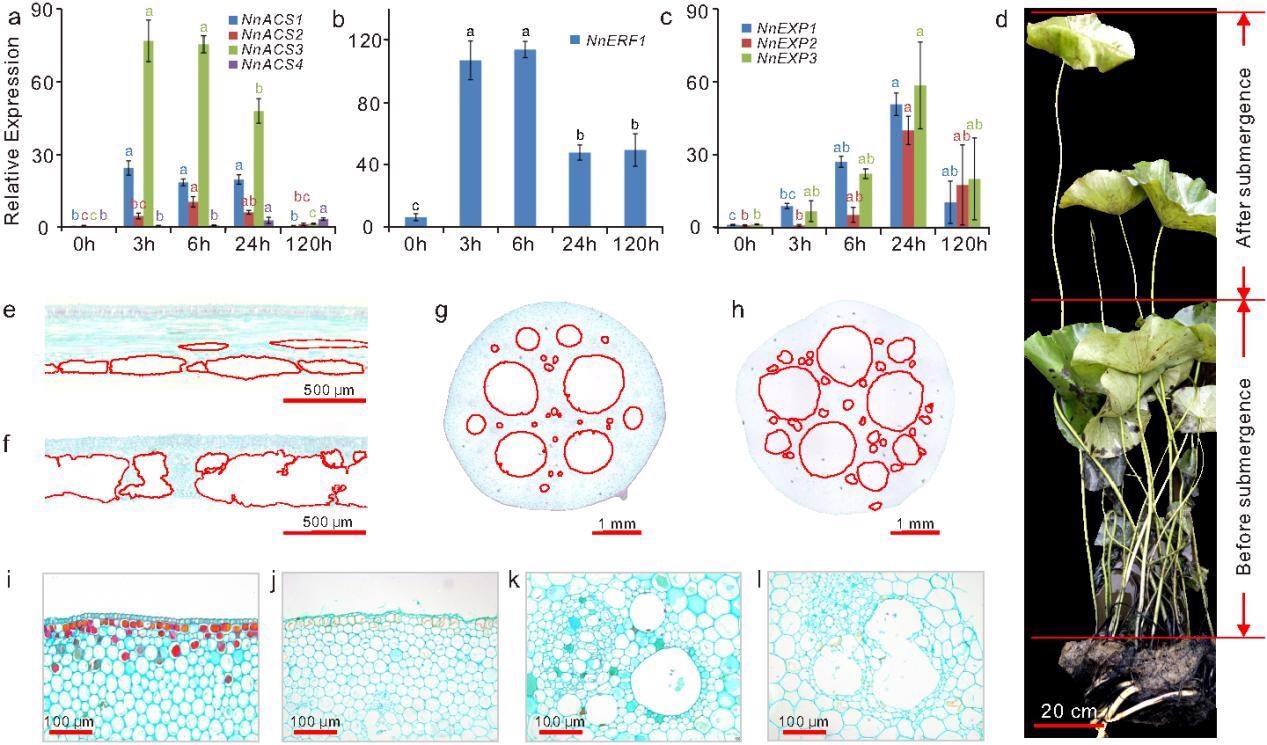Lotus (Nelumbo nucifera) is an aquatic emergent plant that is frequently grown in Asian countries. The increasing frequency of unfavorable weather occurrences, such as heavy rain, puts it under constant strain. As a result, the lotus may be flooded for an extended period, or even completely submerged. As a result, research on the tolerance and adaptation processes of lotus to complete submersion is critical.
 Lotus plants take primarily the low-oxygen escape strategy. Genes encoding ACC synthases (a), Ethylene marker protein NnERF1 (b), and expansions (NnEXPs) (c) were significantly up-regulated. (d) Lotus under complete submergence developed dramatically elongated petioles. (e-l), lotus leaf and petiole contain high-density aerenchyma under complete submergence. Image Credit: Wuhan Botanical Garden
Lotus plants take primarily the low-oxygen escape strategy. Genes encoding ACC synthases (a), Ethylene marker protein NnERF1 (b), and expansions (NnEXPs) (c) were significantly up-regulated. (d) Lotus under complete submergence developed dramatically elongated petioles. (e-l), lotus leaf and petiole contain high-density aerenchyma under complete submergence. Image Credit: Wuhan Botanical Garden
By executing time-course complete submergence in two lotus types, “Qiuxing” and “China Antique,” Dr Xianbao Deng and Dong Yang, along with a colleague at the Chinese Academy of Sciences’ Wuhan Botanical Garden, have documented the key response methods of lotus to complete submergence.
The two lotus kinds displayed little tolerance to complete submersion, according to the scientists, with a median fatal period of roughly 10 days. Lotus plants that were completely submerged had thinned leaves, fast extended petioles, and a high density of aerenchyma, indicating that they had adopted the low oxygen “escape” strategy (LOES). Submergence rapidly triggered gene sets important to LOES, such as the NnERF-VII genes.
Genes associated with lotus innate immunity and reactive oxygen species clearance were tweaked to help the lotus adapt to total submersion. Jasmonic acid may also have a role in mediating the lotus submergence response, according to the findings.
These findings reveal for the first time that the LOES approach is used by lotus to deal with submergence-induced complex burdens, and they will help researchers better understand the various mechanisms that plants use to respond to submergence, as well as provide important genetic sources for breeding submerging-tolerant lotus cultivars.
The National Science Foundation of China, the CAS Key Research Program of Frontier Science, and the CAS Youth Innovation Promotion Association all contributed to this study.
Source:
Journal reference:
Deng, X., et al. (2022) Time-course analysis and transcriptomic identification of key response strategies of Nelumbo nucifera to complete submergence. Horticulture Research. doi.org/10.1093%2Fhr%2Fuhac001